
Table of Contents
1. Importance of Natural Lighting in Buildings
Building orientation plays a crucial role in maximizing natural sunlight and reducing the need for artificial lighting. By strategically aligning a building with the path of the sun, designers can harness natural lighting to create bright, inviting spaces while minimizing energy consumption. Considerations such as latitude, local climate, and nearby obstructions should inform the orientation of a building to ensure that it receives optimal sunlight throughout the day.
Moreover, proper building orientation can contribute to increased thermal comfort by allowing daylight to penetrate deeper into interior spaces. This not only reduces reliance on heating and cooling systems but also enhances the overall well-being of occupants. Architects and engineers must therefore leverage innovative design strategies that capitalize on solar angles and seasonal variations to achieve maximum daylight exposure from different orientations, ultimately optimizing energy efficiency and creating healthier living environments.
2. Understanding the Principles of Daylighting
Incorporating light-reflective surfaces and materials into building design not only enhances natural lighting but also helps to create visually stunning interior spaces. Utilizing materials such as polished concrete, stainless steel, and ceramic tiles can effectively bounce natural light deep into a room, reducing the need for artificial lighting during daylight hours. Furthermore, incorporating light-reflective roofing materials on top of buildings can help to mitigate heat gain and reduce the need for excessive air conditioning.
Architects and designers are increasingly looking towards innovative solutions like integrating prismatic glass or mirrors into building facades to redirect sunlight deeper into interior spaces. This approach not only reduces energy consumption but also creates dynamic visual effects that add a sense of depth and movement within the built environment. By strategically incorporating these light-reflective surfaces and materials, architects have the opportunity to craft environments that prioritize both sustainability and aesthetic appeal in equal measure.
3. Utilizing Building Orientation for Maximum Sunlight
Strategic placement of windows and skylights is paramount in optimizing natural lighting within a building. Thoughtful consideration should be given to the orientation of the building in relation to the sun’s path throughout the day, as this can significantly impact the amount of natural light that enters the space. By strategically placing windows and skylights, designers can manipulate the intensity and direction of sunlight, creating a harmonious balance between illumination and shading.
Moreover, strategic placement of windows and skylights can influence the overall aesthetics and ambiance of a space. Carefully positioned windows can frame scenic views or create focal points within a room, while well-placed skylights can evoke an open, airy feel. Additionally, leveraging these architectural elements allows for better control over ventilation and temperature regulation, contributing to a more comfortable environment for occupants. Ultimately, when executed purposefully, strategic window and skylight placement not only maximizes natural light but also enhances the overall experience within a building.
4. Incorporating Light-Reflective Surfaces and Materials
Smart shading solutions are a crucial element in the quest for optimal natural lighting in building design. By incorporating automated shades, buildings can dynamically adjust to changing light conditions throughout the day, maximizing natural light while minimizing glare and heat gain. This not only enhances the comfort of occupants but also reduces energy consumption by lowering the reliance on artificial lighting and HVAC systems.
One innovative approach is to integrate smart shading systems with sensor technology that can detect changes in sunlight intensity and orientation. This allows for real-time adjustments, ensuring that the right amount of natural light enters the space without compromising on visual comfort or energy efficiency. Additionally, advanced control systems enable programming based on seasonal variations, further optimizing natural light utilization without sacrificing privacy or aesthetics within the building.
Ultimately, implementing smart shading solutions presents an opportunity to elevate building design by seamlessly integrating sustainability, comfort, and aesthetics. It’s a powerful tool that enables architects and designers to create spaces that harness the full potential of natural light while addressing the evolving needs of modern occupants.
5. Strategic Placement of Windows and Skylights
In conclusion, the benefits of well-designed natural lighting are undeniable. By strategically incorporating natural light into buildings, we can enhance both the aesthetic and functional aspects of spaces. Research has shown that exposure to natural light can improve mood, productivity, and overall well-being. Furthermore, reducing reliance on artificial lighting not only lowers energy consumption but also contributes to a sustainable and environmentally friendly approach to building design.
Moreover, well-designed natural lighting has been proven to positively impact our circadian rhythm, promoting better sleep patterns and overall health. When thoughtfully integrated into architectural design, natural light has the potential to create visually stunning effects, connecting occupants with the outside world while providing a sense of openness and spaciousness within indoor environments. Ultimately, embracing well-designed natural lighting is not just about creating beautiful spaces – it’s about fostering healthier lifestyles and contributing to a more sustainable future for all.
6. Implementing Smart Shading Solutions
Implementing smart shading solutions is a crucial aspect of designing buildings for optimal natural lighting. By strategically incorporating automated blinds or shades, architects and designers can harness the power of sunlight while also minimizing glare and heat gain. Modern technological advancements have made it possible to integrate smart shading systems that are responsive to changing light conditions, providing both energy efficiency and occupant comfort.
One exciting trend in smart shading solutions is the use of sensors and automation to adjust shades based on real-time data. This not only optimizes natural light levels throughout the day but also reduces reliance on artificial lighting, leading to substantial energy savings. Additionally, these intelligent shading systems can be programmed to respond to seasonal variations, further enhancing the building’s overall sustainability.
By embracing these innovative technologies, designers can create spaces that not only maximize natural light but also offer a dynamic and adaptable environment for their occupants. Smart shading solutions contribute to a holistic approach to building design, where energy efficiency and human-centric design principles intersect harmoniously. As the demand for sustainable architecture continues to rise, integrating smart shading solutions will undoubtedly become an integral part of creating buildings with optimal natural lighting.
7. Conclusion: Benefits of Well-Designed Natural Lighting
In conclusion, the benefits of well-designed natural lighting in buildings are multi-faceted and profound. From enhancing the aesthetics of a space to contributing to occupant well-being, natural lighting has a transformative impact on our built environment. Studies have consistently demonstrated that exposure to natural light can improve productivity, mood, and overall health, making it an essential consideration in architectural design.
Furthermore, the energy-saving potential of well-designed natural lighting cannot be overstated. By harnessing sunlight effectively, buildings can reduce their reliance on artificial lighting and heating systems, leading to significant cost savings and environmental benefits. Additionally, the visual connection to nature provided by ample natural light fosters a sense of connection to the outside world, creating spaces that are both inviting and nurturing for their occupants. Ultimately, integrating optimal natural lighting into building design not only elevates the quality of architecture but also positively impacts human experience in profound ways.




